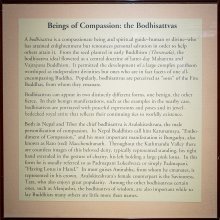Compassion: 2 definitions
Introduction:
Compassion means something in Hinduism, Sanskrit. If you want to know the exact meaning, history, etymology or English translation of this term then check out the descriptions on this page. Add your comment or reference to a book if you want to contribute to this summary article.
Images (photo gallery)
(+11 more images available)
In Hinduism
Shilpashastra (iconography)
Source: Shodhganga: Elements of Art and Architecture in the Trtiyakhanda of the Visnudharmottarapurana (shilpa)Compassion is associated withe the Pathetic Sentiment (karuṇa), which refers to one of the Nine Sentiments (citrarasa) in ancient Indian Painting (citra), according to the Viṣṇudharmottarapurāṇa, an ancient Sanskrit text which (being encyclopedic in nature) deals with a variety of cultural topics such as arts, architecture, music, grammar and astronomy.—The karuṇarasa i.e., the pathetic sentiment is reflected through a Painting in which a painter creates pathos on the basis of the actions projecting begging, separation, calamity, compassion etc. [...] Thus, painting is a medium of showing the inner feelings and emotions of a painter which can strikes the inherent sentiments of connoisseur’s mind, for example: compassion in the sentiment of pathos.

Shilpashastra (शिल्पशास्त्र, śilpaśāstra) represents the ancient Indian science (shastra) of creative arts (shilpa) such as sculpture, iconography and painting. Closely related to Vastushastra (architecture), they often share the same literature.
Yoga (school of philosophy)
Source: ORA: Amanaska (king of all yogas): A Critical Edition and Annotated Translation by Jason BirchThe Compassion (of a true Guru) is denoted in the Sanskrit language as Karuṇā, according to the Haṭhapradīpikā of Svātmārāma: an influential 15th-century Sanskrit manual on Hatha-Yoga dealing with techniques to channel one’s vital energy.—Accordingly, “Giving up sense objects is difficult to achieve; seeing the highest reality is [also] difficult, and [so too] is attaining the natural state [of Samādhi], without the compassion (karuṇā) of a true Guru”.

Yoga is originally considered a branch of Hindu philosophy (astika), but both ancient and modern Yoga combine the physical, mental and spiritual. Yoga teaches various physical techniques also known as āsanas (postures), used for various purposes (eg., meditation, contemplation, relaxation).
See also (Relevant definitions)
Starts with: Compassionate.
Full-text (+934): Karuna, Anukampa, Karunya, Anukrosha, Anukampana, Daya, Bhutadaya, Ghrina, Avalokiteshvara, Mahakaruna, Karpanya, Kripa, Ghrinitva, Nikkaruna, Akaruna, Brahmavihara, Vitulanem, Aghrina, Karunakirttana, Ardra.
Relevant text
Search found 329 books and stories containing Compassion; (plurals include: Compassions). You can also click to the full overview containing English textual excerpts. Below are direct links for the most relevant articles:
Mahabharata (English) (by Kisari Mohan Ganguli)
Section CLII < [Apaddharmanusasana Parva]
Section CXIV < [Anusasanika Parva]
Section CLXIII < [Apaddharmanusasana Parva]
The Scientific Outlook Of Buddhism (by Wang Chi Biu)
Chapter 5 - The Positive Spirit Of Buddhism
Chapter 3 - The Buddhist Theory Of Equality
12th Imperishable, Compassion.
1st Imperishable, Generating the Thought of Awakening
35th Imperishable, Presence of Recollection Concerned with Feelings.
Let the Stream of Compassion flow < [July – September 1975]
India’s Social Culture: Its Use and Abuse < [April – June, 1988]
Compassion < [April – June, 2003]
The Great Chariot (by Longchenpa)
Part 3 - Meditation on Compassion < [G. How to meditate]
H. Further explanation of the way of meditating < [Chapter VII - The Four immeasurables]
A. The description of the four Brahma-viharas < [Chapter VII - The Four immeasurables]
Cetasikas (by Nina van Gorkom)
Chapter 33 - Compassion And Sympathetic Joy < [Part IV - Beautiful Cetasikas]
Appendix 8 - Appendix To Chapter 31 < [Appendix And Glossary]
Chapter 30 - Equanimity < [Part IV - Beautiful Cetasikas]
Related products
(+2 more products available)











